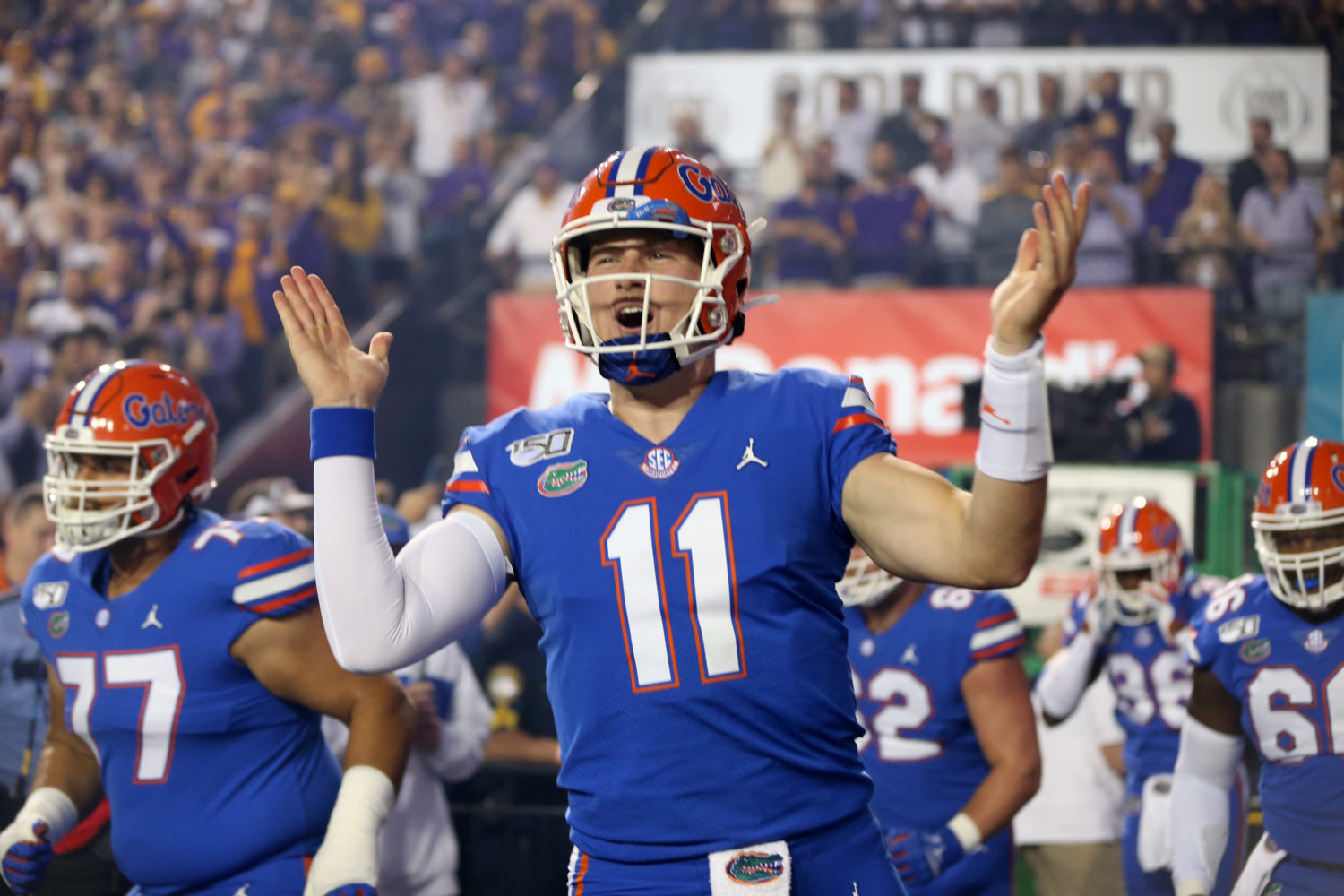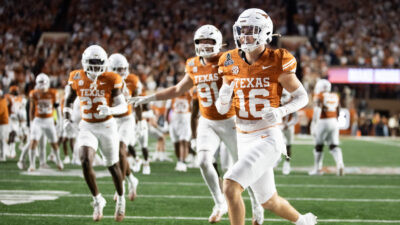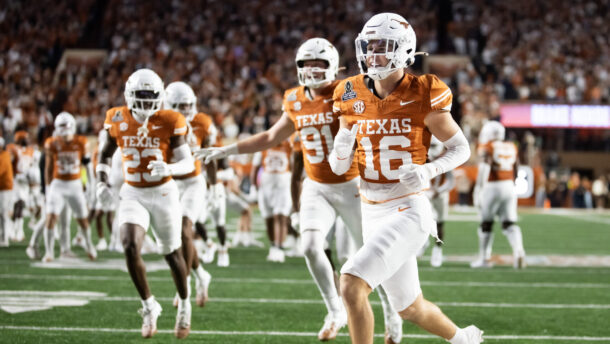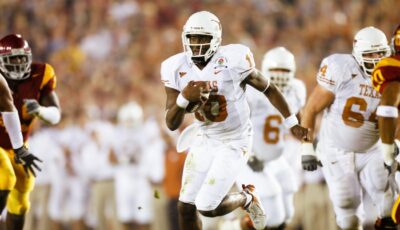
It raised eyebrows when, in our SDS 10 bold predictions for Florida’s 2020 season, we tapped Kyle Trask as a future Heisman finalist.
On paper, the idea of Kyle Trask, the backup quarterback afterthought who never started a varsity football game in high school, joining the likes of Clemson’s Trevor Lawrence, Texas’ Sam Ehlinger and, should the B1G come to its senses, Ohio State’s Justin Fields in New York City for the Heisman Trophy ceremony seems like the plot of an uplifting but unlikely Disney film.
Trask doesn’t need to be a Heisman finalist to be a remarkable story.
By now, you probably have been Rip Van Winklin’ if you don’t know the background, but Trask entered the 2019 season having not started a football game since freshmen football in Manvel, Texas. A 2-star recruit (Trask received a 3rd star after he committed to Florida but wasn’t among the top 2,000 recruits in the 2016 class in the 247 composite), then-Florida assistant Doug Nussmeier spotted Trask while scouting another player on a Texas recruiting trip. Nussmeier told Jim McElwain he liked the kid’s prototypical size and strong arm, and McElwain offered him a scholarship. After signing with Florida, Trask languished on the bench, a popular “he’s pushing so and so” anecdote in a number of Florida quarterback competitions, but never the guy at the top of the depth chart.
All that changed last September when Feleipe Franks was lost for the season with a leg injury on a freakish play late in the second half in Lexington.
With the Gators trailing by multiple scores, in stepped Trask, who in rallying Florida from 11 behind to a 29-21 victory didn’t just rescue Florida from a second consecutive loss to Kentucky, but transformed the trajectory of Florida’s season.
Trask started the next 10 games, throwing for nearly 3,000 yards in the process and tossing 25 touchdown passes against only 7 interceptions. Trask’s single-season QB rating was the highest for any Florida quarterback since Tim Tebow in 2009, helping the Gators win 11 games and an Orange Bowl. It was the most moving rags to riches type quarterback story at Florida since walk-on quarterback Kerwin Bell, known in Hogtown as “the throwin’ Mayoan,” helped Florida to a No. 1 ranking (New York Times and Sagarin polls) and SEC Championship in 1984– national and conference championships Florida does not claim due to being placed on NCAA probation.
Trask now returns for his senior season as the most productive returning quarterback in the SEC, and his head coach has praised his offseason improvement, recently telling the media that “(Trask) is much-improved, especially with the speed of how he makes decisions and the way he more consistently makes the right decision.”
That’s hefty praise from someone like Dan Mullen, a coach who has earned his status as a quarterback whisperer by consistently coaxing huge production leaps from starting quarterbacks playing in their second year as a starter in his system.
Tim Tebow won the Heisman as a first-year starter under Mullen, but that was in his second year as a regular contributor. Other Mullen quarterbacks, including Alex Smith, Chris Leak and Dak Prescott, made immense leaps in Year 2 as Mullen’s starter.
At Utah, Smith posted 2,247 passing yards, 15 touchdowns, 3 interceptions and a 65.0 percent completion rate along with 452 rushing yards and 5 touchdowns as a first-year starter. As a junior, he doubled his passing and rushing TDs as a junior, threw for 2,952 yards and saw his quarterback rating improve by nearly 25 points, from 152.3 to 176.5. Those numbers helped Smith finish 4th in the Heisman voting and become the No. 1 pick in the 2005 NFL Draft.
At Florida, Chris Leak had already led the SEC in passing when Mullen arrived. Mullen taught the quarterback a new system, but he had been turnover prone. While learning a new offense was an adjustment for Leak, he threw just 6 interceptions after 12 in 2004 and improved his completion rate from 59.6 to 62.8%. Leak finished the 2005 season with 2,639 yards and 20 touchdowns, along with 6 rushing scores. Despite sharing snaps with Tebow in 2006, Leak increased his passing yards, passing TDs, completion percentage (career-best .636) and QB rate from 136.5 to 144.9 in leading the Gators to the 2006 national championship. Leak finished his career with an epic performance in the national title game against No. 1 Ohio State, capturing BCS Championship Game MVP honors.
At Mississippi State, Dak Prescott, like Trask, became the starter due to the injury of the incumbent. Prescott started 7 games after Tyler Russell was hurt, finishing the year with 1,940 passing yards, 829 rushing yards and 23 total touchdowns accounted for (10 passing, 13 rushing). Like Franks, Russell left school, and Prescott became a national sensation in his first year as a full-time starter, landing on the cover of Sports Illustrated and leading the Bulldogs to their first No. 1 ranking in program history after 3 consecutive wins over top-10 teams. Statistically, Dak smashed 10 school records, including single-season passing yards (3,449), rushing yards by a QB (986), total yards (4,435), passing touchdowns (27) and total touchdowns (41). He earned the first of two First-Team All-SEC selections and was a 2014 finalist for the Maxwell, Davey O’Brien and Johnny Unitas Awards.
In other words, quarterbacks tend to thrive under center the longer they play for Mullen, and if Mullen says Trask is much-improved, it’s best to take his word for it.
You’d think, then, that tapping Trask as a potential Heisman finalist — we didn’t predict he’d win, mind you — wouldn’t be particularly controversial.
But apparently it is, and the reasons for that are worth exploring.
First, there’s the PFF criticism.
Pro Football Focus’ rankings and its ability to break down the efficiency of individual players in the ultimate team sport has helped the service attain a cult following in recent years, often for very good reason.
PFF, put plainly, isn’t wild about Trask, going so far as to call him the “prime reason” in college football in 2020 “not to trust the box score.” PFF rates Trask in the bottom half of the country among eligible returning starters, at 73rd of 103. It noted he attained a PFF grade of 70.0 or higher (considered a good game) only twice in 1o starts last season. And while PFF praises his accuracy (11th in college football in 2019, in the PFF formula), it doubts his ability to avoid turnovers (a metric they call turnover-worthy plays, whereby its formula Trask finished in the bottom 10) and to produce big plays (another metric where its formula places him in the bottom 10). So what to make of that?
First, it’s worth noting that PFF formulas sometimes create bizarre results.
A recent example? PFF ranked FSU’s defensive line as the best in the country entering the 2020 season, which to the formula meant a huge win Saturday against Georgia Tech, a young offensive line playing with a freshman quarterback.
Florida State has the best defensive line in the country
Georgia Tech just transitioned from triple option to real passing concepts last year
That’s gonna be a bloodbath
— Mike Renner (@mikerenner_) September 12, 2020
How did that play out? Not well for the PFF calculators or the Seminoles.
Easy digs aside, there are other numbers suggesting that perhaps PFF gives too much weight to the somewhat arbitrary “turnover-worthy” throw metric.
After all, Trask enters 2020 with the best Success Rate, First Down+Touchdown Rate, and Uncatchable Pass Rate among SEC quarterbacks.
These are signs he can recognize what a defense gives him, and avoid danger when it is present. This film reveiw, done by former UGA quarterback Huston Mason, shows how the cerebral part of Trask’s game — an area Mullen has specifically praised growth in during the offseason — makes him so valuable.
As I was preparing to call the Gators spring game weeks ago, I noticed one thing on tape of Kyle Trask that reminded me an old Peyton Manning story. @SECNetwork @GatorsFB pic.twitter.com/4Ryp8UsCML
— Hutson Mason (@HMason14) April 22, 2020
Even if you account for the high number of short passes Trask was tasked with completing last season, Trask appears to have a very high floor as a thrower. First, he produced as much as he did last season despite the lack of any consistent run game. Mullen loves play-action, and Florida should offer more balance, and as such better deception on play-action, in 2020.
Trask is also a very effective thrower in the intermediate passing game (within 10-20 yards). On those plays, Trask posted PFF grades of 82.2 (left), 71.4 (middle) and 78.4 (right) and threw for 967 yards and 5 touchdowns. Trask went 56-for-97 within this range, which averages out to about 57.7%, despite the fact he faced pressure on 47% of these throws, per Stats Solutions. That shows his composure and accuracy aren’t negotiable.
In fact, Trask’s numbers under pressure or in clean pockets on dropback passes both show success rates over 50%. He’s the lone SEC quarterback who returns with that level, and 1 of 3 over 50% in clean pockets. That’s all the more impressive when you consider Florida’s young offensive line allowed pressure on 36% of drop-backs, per Stats Solutions, a number which ranked 12th in the SEC and in the bottom third of the FBS.
If Florida’s offensive line improves, as expected, Trask will likely have more clean pockets and be able to clean up both the fumbles when hit and dangerous throws, both of which limited his effectiveness. If those reasonable events occur, a significant jump from Trask isn’t just possible — it should be expected.
Beyond other metrics, Trask also compares very favorably with the nation’s best quarterbacks against common opponents and elite defenses, at least on paper.
Take Trevor Lawrence.
Trask and Lawrence played 3 common opponents in 2019: LSU, South Carolina and Virginia. It is noteworthy that Lawrence played 2 of these games on neutral fields (LSU, Virginia) whereas Trask played 2 true road games (at LSU, at South Carolina). The Gators’ quarterback, lacking the power running attack that Lawrence had at his disposal, compares favorably.
[table “” not found /]But how did they fare against the best defenses?
Using the S &P+ defensive efficiency metric, I looked at the numbers for Trask as opposed to consensus Heisman contenders Lawrence and Sam Ehlinger, of Texas. Trask faced 5 S &P+ Top 25 defenses in his 10 starts: Auburn, at LSU, at Missouri, Georgia (neutral) and Tennessee. Lawrence faced 3: LSU and Ohio State (neutral) and Texas A&M. Sam Ehlinger faced 4: LSU, at Iowa State, at Baylor and Utah (neutral). Here are the numbers:
[table “” not found /]While both Lawrence and Ehlinger can beat you with their legs — a difference between them and Trask that is certainly important — the passing numbers for Trask are comparable, and in some instances — such as yards per attempt, favorable.
In other words, Trask is a battle-tested kid who has produced against outstanding defenses. He wasn’t padding his numbers against Vanderbilt only to come back to earth in big games. Does any of this guarantee the type of leap it would take for Trask to receive an invite to the Heisman ceremony? Nope. But it’s reasonable, given Mullen’s track record, Trask’s 2019 numbers, and the attention a starting quarterback in Gainesville, Florida receive nationally, to suggest that it could happen, especially if Florida contends for a College Football Playoff spot.
Kyle Trask isn’t flashy. He doesn’t have Feleipe Franks’ rocket arm or Sam Ehlinger’s penchant for the spectacular or Joe Burrow’s moxie or Trevor Lawrence’s fantastic hair.
What he does have is a calmness, a quiet confidencem, a relentless small-town Texas type work ethic, and a play-caller whose system fits him very well.
In this strangest of seasons, that might be enough. Trask for Heisman? Why not?
Neil Blackmon covers Florida football and the SEC for SaturdayDownSouth.com. An attorney, he is also a member of the Football and Basketball Writers Associations of America. He also coaches basketball.







